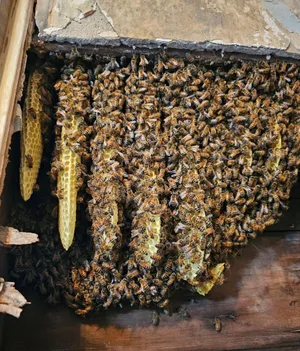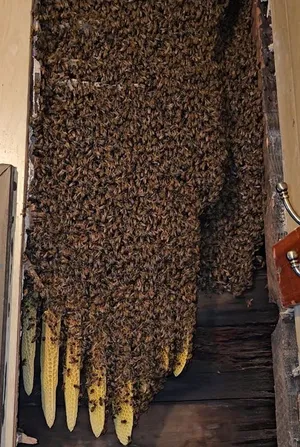Massive honeybee colony takes over Pennsylvania home; thousands removed from walls

A Pennsylvania homeowner found herself in a potentially sticky situation when she discovered thousands of honeybees buzzing in the walls of her home.
They had become a real nuisance in recent weeks, her neighbors had started to complain.
Even the mailman had threatened to stop delivering the mail, which is why she reached out to HoneyBee Blues, a business that specializes in “swarm removal and hive removal” just outside of Pittsburgh.
Joe Kellems, HoneyBee Blues co-owner, told USA TODAY Friday that the situation is “actually very common.”
“I think a lot of people don’t realize it until its too late because a lot of times, they are up in between the first and second floor. That’s above everybody’s eyesight so people don’t always look up until, again, its too big of a problem. And by that time people like us are needed to come out, locate them and get them out safely,” he said.
Kellems said he and his business partner, Dawan Johnson, field these kinds of calls regularly. And even more, now, with all the news stories that have come out since they treated the home on April 8.
Here’s what we know.
Four hours and thousands of honeybees later
The pair traveled to Homestead, a borough seven miles southeast of downtown Pittsburgh, to get a better look. They told the woman that they would be providing the service free of charge, which is something they have done quite a few times.
“We try to help out the best we can, offering our services for free for people down on their luck, or unable to afford the cost of service. It’s a bad situation when you walk in and somebody’s got a giant colony of bees and they’re barely able to afford to get by themselves,” Kessems said.

They also like to make the interaction as personal as possible because “we’re cutting into their home” to get these bees out. They got suited up, covering their scents with smoke before entering the home.
HoneyBee Blues even got some good press out it, offering complimentary service in exchange for permission to feature her home on TV. Kellems says they would’ve done it for free even if the local reporter hadn’t come out.
“Judging by that, it’s going to be a big hive. I would say 4 to 5 feet high. It’s probably 12 inches wide. It’s probably the third biggest one we’ve done. I would say they’ve probably been there for over two years,” Kellems shared with KDKA-TV.
It took about more than four hours to remove between 5,000 and 8,000 honeybees from the home, working slowly to avoid agitating the bees. Kellems uses a thermal imager to figure out where the bees are inside of the structure before coming up with a “game plan.”
The thermal imager helped him locate the wood studs placed behind the wall, then moves to the chunk of wall in between the studs so he can “reattach it easily.”
“And once I take that material off, the bees are are usually hanging at the top of the framing and inside the wall or the braces as I go across,” Kellems said.
They then have to figure out the best way to cut the honeycomb out of wall, cutting it out piece by piece. They set up a couple of boxes, placing pieces of the comb inside. Kellems, say they wait and “hope” that the bees will go into one of the boxes. The bees “fan” the pheromones of the queen about so the rest of the bees are able to find the new hive location.
Clean up is the last step in the removal process, picking up any stray pieces of comb, sucking up any loose bees in a vacuum and cleaning any honey that may be inside the wall.
They also use insulation material to stuff the opening the bees may have used to get inside the wall, preventing them from establishing another colony. Kellems did take the bees home, integrating them on his bee farm.
Kellems says the client was “very thankful” after it was all said and done.
“She was so happy. She was definitely feeling the stress … So, she was very happy to get them out of there and very thankful for what we were able to do for her.”
Home maintenance is essential, easy to prevent situations like this
The best thing you can do to prevent a situation like this from happening to you is to make sure “all your window seals are are sealed up.”
“Its a lot of normal, basic things that don’t get kept up on. And a lot of times that’s exactly how the bees get in … If there’s a broken seal on a window or on a doorframe or anywhere, that’s where they go 100% of the time," Kellems said. "It's been very rare that I've I've found it in in a different place.”
Don’t hesitate to reach out to a “local beekeeping organization” if you find yourself in a similar situation. There will always be someone who is willing to come out and help, Kellems said.
“It's a stressful [situation] but it's not the end of the world,” he said.
Disclaimer: The copyright of this article belongs to the original author. Reposting this article is solely for the purpose of information dissemination and does not constitute any investment advice. If there is any infringement, please contact us immediately. We will make corrections or deletions as necessary. Thank you.






